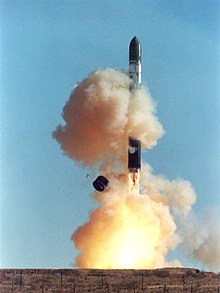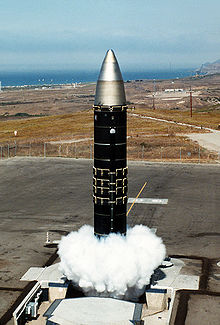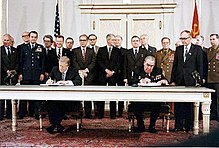START I

The START I treaty expired 5 December 2009. On 8 April 2010, the new START treaty was signed in Prague by U.S. President Obama and Russian President Medvedev. It will enter into force after its ratification through the parliaments of both countries.
Contents[show] |
[edit] Proposal
At the time the US had a commanding lead in strategic bombers. The US B-52 force, while aged, was a credible strategic threat but was only equipped with AGM-86 cruise missiles, beginning in 1982, because of Soviet air defense improvements in early 1980s. The US also had begun to introduce new B-1B Lancer quasi-stealth bomber and was secretly developing the Advanced Technology Bomber (ATB) project that would eventually result in the B-2 Spirit stealth bomber. The USSR's force was of little threat to the US, on the other hand, as it was tasked almost entirely with attacking US convoys in the Atlantic and land targets on the Eurasian landmass. Although the USSR had 1,200 medium and heavy bombers, only 150 of them (Tupolev Tu-95s and Myasishchev M-4s) could reach North America (the latter only with in-flight refueling). They also faced difficult problems in penetrating admittedly smaller and poorly defended US airspace. Possessing too few bombers available when compared to US bomber numbers was evened out by the US forces having to penetrate the much larger and heavier defended Soviet airspace. This changed when new Tu-95MS and Tu-160 bombers appeared in 1984 equipped with first Soviet AS-15 cruise missiles. By limiting the phase-in as it was proposed, the US would be left with a strategic advantage, for a time.
As Time magazine put it at the time, "Under Reagan's ceilings, the U.S. would have to make considerably less of an adjustment in its strategic forces than would the Soviet Union. That feature of the proposal will almost certainly prompt the Soviets to charge that it is unfair and one-sided. No doubt some American arms-control advocates will agree, accusing the Administration of making the Kremlin an offer it cannot possibly accept—a deceptively equal-looking, deliberately nonnegotiable proposal that is part of what some suspect is the hardliners' secret agenda of sabotaging disarmament so that the U.S. can get on with the business of rearmament." However, Time did point out that, "The Soviets' monstrous ICBMs have given them a nearly 3-to-1 advantage over the U.S. in "throw weight"—the cumulative power to "throw" megatons of death and destruction at the other nation."
[edit] Negotiations
Continued negotiation of the START process was delayed several times because US agreement terms were considered non-negotiable by pre-Gorbachev Soviet rulers. President Reagan's introduction of the Strategic Defense Initiative program in 1983 was viewed as a threat by the Soviet Union, and the Soviets withdrew from setting a timetable for further negotiations. Due to these facts, a dramatic nuclear arms race proceeded during the 1980s, and essentially ended in 1991 by nuclear parity preservation at a level of more than ten thousand strategic warheads on both sides. This treaty also stated that the United States and Russia would have 6,000 fighter aircraft, 10,000 tanks, 20,000 artillery pieces and 2,000 attack helicopters.[edit] Ratification
It was signed on July 31, 1991, five months before the collapse of the Soviet Union. Entry-into-force was delayed due to the collapse of the USSR and awaiting an Annex that enforced the terms of the treaty upon the newly independent states of Russia, Belarus, Kazakhstan, and Ukraine. The latter three agreed to transport their nuclear arms to Russia for disposal.It remains in effect between the U.S. and Russia, Belarus, Kazakhstan, and Ukraine These latter three have disarmed since becoming independent nations in the wake of the break up of the Soviet Union.
Today, the United States has 3,696 and Russia has 4,237 deployed strategic warheads. The US has roughly 10,000 total warheads, counting strategic and tactical, both deployed and in reserves. The figures for Russia are less reliable, but are considered to be in the range of 15,000 to 17,000 total warheads.[3]
[edit] Implementation
"It remains in effect between the U.S. and Russia, Belarus, Kazakhstan, and Ukraine. The latter three became non-nuclear weapons states under the Treaty on the non-proliferation of Nuclear Weapons of July 1, 1968 (NPT) as they committed to do under the "Lisbon Protocol" (Protocol to the Treaty Between the United States of America and the Union of Soviet Socialist Republics on the Reduction and Limitation of Strategic Offensive Arms) after becoming independent nations in the wake of the break up of the Soviet Union." [5][6]
[edit] Efficacy
Belarus, Kazakhstan and Ukraine have disposed of all their nuclear weapons or transferred them to Russia; while the U.S. and Russia have reduced the capacity of delivery vehicles to 1,600 each, with no more than 6,000 warheads.[7]A report by the US State Department called "Adherence to and Compliance With Arms Control, Nonproliferation and Disarmament Agreements and Commitments" which was released on July 28, 2010 stated that Russia was not in full compliance with the treaty when it expired on December 5, 2009. The report did not specifically identify Russia's compliance issues.[8]
[edit] Expiration and renewal
Russian President Dmitri Medvedev, said, the day after the U.S. elections, in his first state of the nation address, that Russia would move to deploy short-range Iskander missile systems in the western exclave of Kaliningrad "to neutralize if necessary the anti-ballistic missile system in Europe." Russia insists that any movement towards a new START should be a legally binding document, and must, then, set lower ceilings on the number of nuclear warheads, and their delivery vehicles.[7]
On March 17, 2009, Russian President Dmitri Medvedev signaled that Russia would begin a "large-scale" rearmament and renewal of Russia's nuclear arsenal. President Medvedev accused NATO of pushing ahead with expansion near Russian borders and ordered that this rearmament commence in 2011 with increased army, naval, and nuclear capabilities. Additionally, the head of Russia's strategic missile forces, Nikolai Solovtsov, told news agencies that Russia would start deploying its next-generation RS-24 missiles after the December 5 expiry of the START-1 treaty with the United States. Russia hopes to change the START-1 treaty with a new accord. The increased tensions come despite the warming of relations between the United States and Russia ever since U.S. President Barack Obama took office.[10]
As of May 4, 2009, the United States and Russia began the process of renegotiating START, as well as counting both nuclear warheads and their delivery vehicles when making a new agreement. While setting aside problematic issues between the two countries, both sides agreed to make further cuts in the number of warheads they have deployed to around 1,000 to 1,500 each. The United States has said they are open to a Russian proposal to use radar in Azerbaijan rather than Eastern Europe for the proposed missile system. The Bush Administration was using the Eastern Europe defense system as a deterrent for Iran, despite the Kremlin's fear that it could be used against Russia. The flexibility by both sides to make compromises now will lead to a new phase of arms reduction in the future.[11]
A 'Joint understanding for a follow-on agreement to START-1' was signed by Presidents Barack Obama and Dmitri Medvedev in Moscow on 6 July 2009. This will reduce the number of deployed warheads on each side to 1,500–1,675 on 500–1,100 delivery systems. A new treaty was to be signed before START-1 expired in December 2009 and the reductions are to be achieved within seven years.[12] After many months of negotiations,[13][14] Presidents Obama and Medvedev signed the successor treaty, Measures to Further Reduction and Limitation of Strategic Offensive Arms, in Prague, Czech Republic on 8 April 2010.
[edit] Memorandum of Understanding data for START 1
| Date | Deployed ICBMs and Their Associated Launchers, Deployed SLBMs and Their Associated Launchers, and Deployed Heavy Bombers | Warheads Attributed to Deployed ICBMs, Deployed SLBMs, and Deployed Heavy Bombers | Warheads Attributed to Deployed ICBMs and Deployed SLBMs | Throw-weight of Deployed ICBMs and Deployed SLBMs (MT) |
|---|---|---|---|---|
| 1 July 2009[15] | 809 | 3,897 | 3,289 | 2,297.0 |
| 1 January 2009[16] | 814 | 3,909 | 3,239 | 2,301.8 |
| 1 January 2008[17] | 952 | 4,147 | 3,515 | 2,373.5 |
| 1 September 1990 (USSR)[18] | 2,500 | 10,271 | 9,416 | 6,626.3 |
| Date | Deployed ICBMs and Their Associated Launchers, Deployed SLBMs and Their Associated Launchers, and Deployed Heavy Bombers | Warheads Attributed to Deployed ICBMs, Deployed SLBMs, and Deployed Heavy Bombers | Warheads Attributed to Deployed ICBMs and Deployed SLBMs | Throw-weight of Deployed ICBMs and Deployed SLBMs (MT) |
|---|---|---|---|---|
| 1 July 2009[15] | 1,188 | 5,916 | 4,864 | 1,857.3 |
| 1 January 2009[16] | 1,198 | 5,576 | 4,514 | 1,717.3 |
| 1 January 2008[17] | 1,225 | 5,914 | 4,816 | 1,826.1 |
| 1 September 1990[18] | 2,246 | 10,563 | 8,210 | 2,361.3 |





